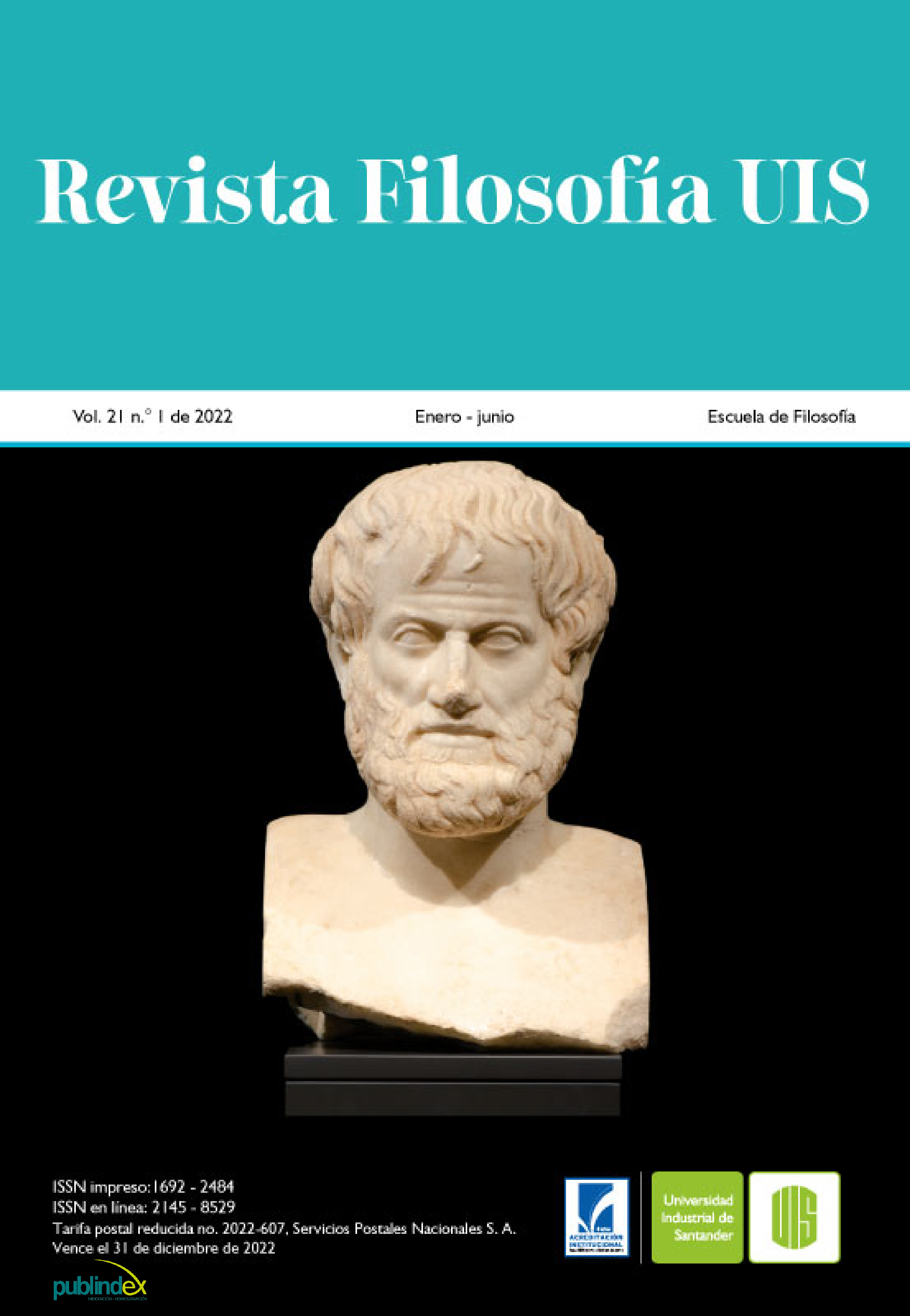Publicado 03-01-2022
Palabras clave
- conciencia,
- reducción-eliminación,
- primera-tercera persona,
- ontología-epistemología,
- sentido común
- neurociencias ...Más
Cómo citar
Derechos de autor 2022 Revista Filosofía UIS

Esta obra está bajo una licencia internacional Creative Commons Atribución 4.0.
Resumen
en el presente texto se evalúan las posibilidades conceptuales de una interpretación fisicalista de la conciencia. Con dicho fin se toman en cuenta posiciones representativas en el ámbito de la filosofía, así como investigaciones neurocientíficas recientes. Ambas líneas de investigación suponen el cuestionamiento de los acercamientos de sentido común al tema de la conciencia. No obstante, no suponen una completa eliminación de lo que dicho acercamiento puede representar. En este sentido, se propone una interpretación epistemológica de la perspectiva intuitiva de primera persona en relación con la perspectiva científica de tercera persona.
Descargas
Citas
- Blackmore, S. (2005). Conversations on Consciousness. Oxford University press.
- Blanco, D. (2000). El Movimiento Fenomenológico. En J. Muguerza y P. Cerezo, (Eds.), La Filosofía Hoy (pp. 65-75). Crítica.
- Braun. R. (2008). El eliminativismo filosófico y su ataque a la psicología. Persona, (011), 51-67. https://doi.org/10.26439/persona2008.n011.923
- Chalmers, D. (1995). The Conscious Mind: In Search of a Fundamental Theory. Oxford University Press.
- Chalmers, D. (1998). On the Search for Neural Correlate of Consciousness. En A. Hameroff, A. Kaszniak & A. Scott (Eds.), Toward a Science of Consciousness II: The First Tucson Discussions and Debates. MIT Press.
- Chalmers, D. (2000). What is a Neural Correlate of Consciousness? En T. Metzinger (Ed.), Neural Correlates of Consciousness: Empirical and Conceptual Issues. MIT Press.
- Chariker, L. Shapley R. & Young L-S. (2016). Orientation Selectivity from Very Sparse LGN Inputs in a Comprehensive Model of Macaque V1 Cortex. Journal of Neuroscience, 36(49), 12368-12384. https://doi.org/10.1523/JNEUROSCI.2603-16.2016
- Churchland, P. S. (1983). Consciousness: The Transmutation of a Concept. Pacific Philosophical Quarterly, 64, 80-95. https://doi.org/10.1111/j.1468-0114.1983.tb00186.x
- Churchland, P. S. (1988). Neurophilosophy. Toward a Unified Theory of the Mind/Brain. MIT Press.
- Churchland, P. (1995). El materialismo eliminativo y las actitudes proposicionales. En E, Rabossi (Ed.), Filosofía de la mente y ciencia cognitiva (pp. 43-68). Paidós.
- Churchland, P. (1999). Materia y Conciencia. Introducción Contemporánea a la Filosofía de la Mente. Gedisa.
- Churchland, P. (2007). The Evolving Fortunes of Eliminative Materialism. En B. McLaughlin & J. Cohen (Eds.), Contemporary Debates in Philosophy of Mind. (pp. 160-182). Blackwelll Publishing.
- Dehaene, S. (2014). Consciousness and the Brain. Deciphering How the Brain Codes Our Thoughts. Penguin Random House.
- Dennett, D. (1991). Consciousness Explained. Back Bay Books.
- Dennett, D. (1998). La Actitud Intencional. Gedisa.
- Dennett, D. (2017). De las bacterias a Bach. La evolución de la mente. (M. Figueras, trad.). Pasado y Presente.
- Descartes, R. (2002). Meditations on First Philosophy (II and IV). En D. Chalmers (Ed.), Philosophy of Mind, Classical and Contemporary Readings (pp. 10-21). Oxford University Press.
- Díez, J. A. y Moulines, C. U. (1997). Fundamentos de Filosofía de la Ciencia. Ariel.
- Dupré, J. (2001). Human Nature and the Limits of Science. Oxford University Press.
- Esparza-Oviedo, S. M. (2020). Similitudes y diferencias en la conceptualización de la conciencia ofrecida por el materialismo eliminativo y el funcionalismo. Un análisis crítico. Revista Filosofía UIS, 19(1), 203-228. https://doi.org/10.18273/revfil.v19n1-2020007
- Gabriel, M. (2016). Yo no soy mi cerebro. Filosofía de la mente para el siglo XXI. Pasado y Presente.
- Gallaguer, S. & Zahavi, D. (2014). La Mente Fenomenológica (M. Jorba, trad.). Alianza Editorial.
- Gazzaniga, M. S. (2000). Cerebral specialization and interhemispheric communication. Does the corpus callosum enable the human condition? Brain, 123(7), 1293-1326. https://doi.org/10.1093/brain/123.7.1293
- Harari, Y. N. (2016). Homo Deus. Breve historia del mañana. (J. Ros, trad.). Debate. Hurvich, L. M. & Jameson, D. (1957). An Opponent-Process Theory of Color Vision. Psychological Review, 64(6), 384-404. https://psycnet.apa.org/doi/10.1037/h0041403
- Jackson, F. (1982). Epiphenomenal Qualia. The Philosophical Quarterly, 32(127), 127-136. https://doi.org/10.2307/2960077
- James, W. (2016). Pragmatismo. (R. del Castillo, trad.). Alianza Editorial.
- Kim, J. (1998). Mind in a Physical World. An Essay on the Mind-Body Problem and Mental Causation. MIT Press.
- Kind, A. (2014). The Case Against Representation about Moods and Emotions. En U. Kriegel (Ed.), Current Controversies in Philosophy of Mind (pp. 113-134). Routledge.
- Koch, Cc. & Tsuchiya (2007). Attention and Consciousness: Two Distinct Brain Processes. Trends in Cognitive Sciences, 11(1), 16-22. https://doi.org/10.1016/j.tics.2006.10.012
- LeDoux, J. E., Wilson, D. H. y Gazzaniga, M. S. (1977). A Divided Mind: Observations on the Conscious Properties of Separated Hemispheres. Ann Neurol, 2, 417-421. https://doi.org/10.1002/ana.410020513
- Llácer, T. (2015). Nietzsche. El Superhombre y la Voluntad de Poder. Batiscafo.
- McFadden, J. (2020). Integrating information in the brain´s EM field: the cemi field theory of conciousness. Neuroscience of Consciousness, 6(1). https://doi.org/10.1093/nc/niaa016
- Mosterín, J. (2008). Conceptos y Teorías en la Ciencia. Alianza Editorial.
- Moya, C. J. (2006). Filosofía de la Mente. Universitat de Valencia.
- Nagel, T. (1974) What is Like to be a Bat? The Philosophical Review, 83(4), 435-450. https://www.jstor.org/stable/2183914?origin=JSTOR-pdf
- Pinker, S. (1998). How the Mind Works. Penguin Random House.
- Ramsey, W. (2019). Eliminative Materialism. En E. Zalta (Ed.), The Stanford Encyclopedia of Philosophy (Spring 2019 Edition). https://plato.stanford.edu/archives/spr2019/entries/materialism-eliminative
- Rovelli, C. (2006). The Disappearance of Space and Time. En Dieks, D. (Ed.), The Ontology of Space Time (pp. 25-36). Elsevier.
- Seager, W. (2016). Theories of Consciousness. An Introduction and Assessment. Routledge.
- Sperry, W., Gazzaniga, M. S. y Bogen, J. E. (1969). Interhemispheric relationships: the neocortical commissures; syndromes of hemisphere disconnection. Handbook of Clinical Neurology, 4, 273-290. https://resolver.caltech.edu/CaltechAUTHORS:20170414-111911293
- Van Riel, R. & Van Gulick, R. (2019). Scientific Reduction. En E. Zalta (Ed.), The Stanford Encyclopedia of Philosophy (Spring 2019 Edition). https://plato.stanford.edu/archives/spr2019/entries/scientific-reduction/
- Wittgenstein, L. (2012). Investigaciones Filosóficas. Crítica.

